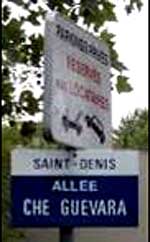General Background
French street names are traditionally displayed printed in white on blue panels, attached to buildings or walls near the street corners.
In Paris and Lyon, cities which have "arrondissements" or numbered suburbs, they indicate which "arrondissement" or district of the city are in. This one is in the 6th "arrondissement" of Paris.

You can find out more about Rue Monsieur le Prince here. You can find out about "La Rue en France" here.
The Avenue des Champs Elysées is probably the best known street in France, since its fame makes it the only street that most of us know!
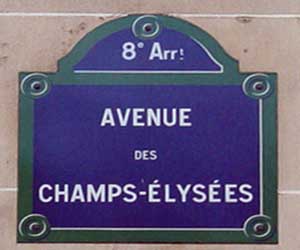
It is also the most important street in France, since it is where the most important national celebrations are held. For example, the Bastille Day Parade on July 14th, when the President takes the salute; or the traditional end of Le Tour de France. It is the street that leads from the Place de la Concorde, with its Egyptian Obelisk, to the Arc de Triomphe. Here, people gather spontaneously for any important national event, such as the million and a half Parisians who came to celebrate the French win of the World Cup football a few years ago.
In mythology, the Elysian Fields were a part of heaven where heroes and virtuous men met after they died. The Champs-Elysées received its name after the French Revolution.
Origins of the street names
The street names have their derivation from a variety of sources: They may be blatantly patriotic, for example:
Rue de la République,
Place de la Libération
Boulevard de la Paix
They may commemmorate local history, or people who died for the country. Street names may relate to an important historical event, or even dates.
- Boulevard du quatorze juillet (Storming of the Bastille - French National Day)
- Rue de la Révolution
- Rue du huit mai (Victory in Europe after World War II)
- Avenue du onze novembre (Armistice Day, end of World War I)
- Place du six juin (D Day)
Some streets may have a traditional name, handed down over centuries. These names related to who lived, or what took place in the streets, or a dominant feature:
- rue des petits puits - lots of little wells in this street
- cour de corbeau - crows must have been a nuisance
- rue des juifs - laws in the Middle Ages forced all Jewish people to live in the same street.
Other streets commemorate a famous person (political, artist, writer, scientist etc) Here are some people who can be found in just about every French town.
- Place Victor Hugo
(France's greatest writer; Hugo wrote plays, poetry, books (The Hunch Back of Notre Dame, Les Misérables) and even found time to be a prominent politician.
- Boulevard Jean Jaurès
(M. Jaurès was a socialist politician who was assassinated for his political views at the outbreak of World War I)
- Rue Jules Ferry
(He was the first Minister
of Education who established free primary schooling in the 1870s. Many thouroughfares bearing his name are near schools).
Street names may relate to an important building or place in the street. Often the names of these streets date back hundreds of years.
- Place de la Gare,
- Avenue de l’Église,
- Rue du Marché
the second sign comes from Alsace and is also written in patois.

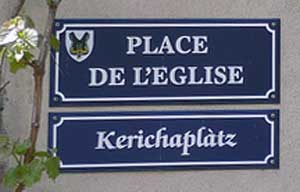
They may be named after a nearby town, or the destination if you follow that road - again named in this way hundreds of years ago.
- Place de Paris
- Avenue de Lyon
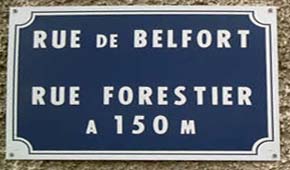
Political correctness and street names
The selection of street names can tell us a lot about the political views of the council that governs the town.
Left wing towns, for example, may honor leaders from the socialist world, such as Lenin and Marx .
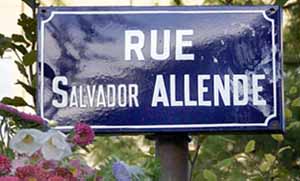
Salvador Allende ( a Chilean President who was assassinated in 1973) and Nelson Mandela are favorite names in the most politically progressive towns with communist governments, such as Bobigny, Montreuil, and Malakoff.
|
This little street remembers the communist Cuban leader. |
However, this can cause problems further down the track when changes of governments or circumstances can make these names "Politically incorrect."
Here are some examples where street names have been changed. Note that the orginal names have still been left in place!
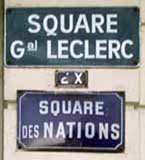 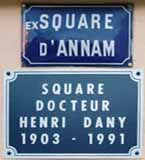
These two streets are in Vichy, the town which hosted the pro-nazi French government after the fall of France in World War II. Many streets were renamed during the German Occupation. At the Liberation, they either reverted to their original name, or were given a totally new one, reflecting war heroes or new political ideas.
Annam in the top sign was an old name for part of French Indo China. Indo China was a French colony which later became North Vietnam under Communist rule. Docteur Dany was a local celebrity.
General Le Clerc was a World War II French general who joined General De Gaulle's Free French army after the surrendur of France to the Nazis.
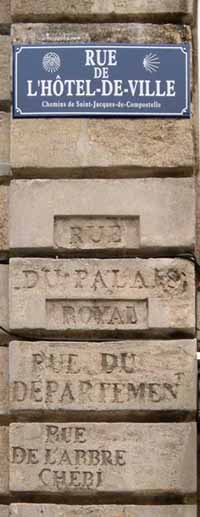
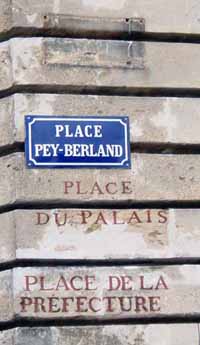
|
These signs come from Bordeau and the ones carved in stone are very old. It is possible they pre-date the Revolution.
Over the years, "political correctness" has forced a few name changes!
Notice how the Street of the Cherished Tree was changed to County/Shire Street, which then became Royal Palace Street and most lately, Town Hall Street. (This presumably after the fall of the Napoleon III Empire in 1870).
Place Pey Berland is one of the most beautiful squares in Bordeau, housing the Cathedral and the Palace of the Archbishop. As you can see, it has undergone more than one name change. This area was named after the Archbishop's Palace, which then became the Prefecture of the region. However, at some stage, it was re-named after one of the early Archbishops, Pey Berland. |

And to end, the Passage of the Broken Heart. This can be found in Tours. The passage way was taken by the condemned before their execution. Hence its rather sad name. |
|
Examples of street names.
This street in a little village in the Auvergne honours a local man who
died during his deportation to the concentration camp of Dachau during World War II.

Likewise, this street commemorates another local hero.
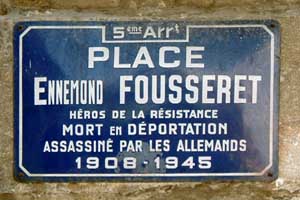
This street commemorates D Day in World War II, on 6th June 1944.
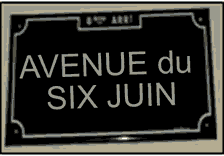
A patriotic street name, celebrating the republic of France!
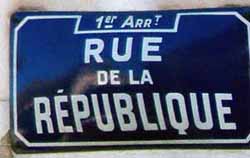
Obviously the First Arrondissement is the place for patriotism.
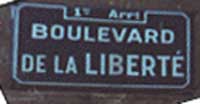
This street commemorates the fall of Emperor Napoleon III on the 4th September 1870 and the creation of the 3rd Republic of France. (There is also a Métro station bearing this name!)

In Vichy, however, the same Emperor is remembered with fondness - he spent a lot of time (and money) in the town, and made it an important centre for the wealthy seeking health cures, entertainment and relaxaton
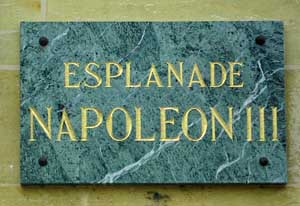
|
This street sign is for the road in Lyon
where the Lumière Brothers lived and worked. They
were the inventors of the first
moving pictures. It was in this street that they made the first movie, filming the workers of their father's factory as they left the premises after a day's work. Whilst the movie only lasted for about a minute, it amazed the first movie goers in Paris in 1896!
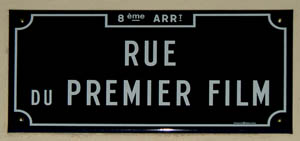
Those who fought in the colonial wars in North Africa are honoured in Vichy.
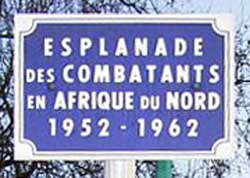
|
This is a veryancient street in the Vieux Quartier of Lyon, which dates back to the 3rd century CE, however, the bull was carved in the 16th century, and the street given its name of "La rue du boeuf" then.
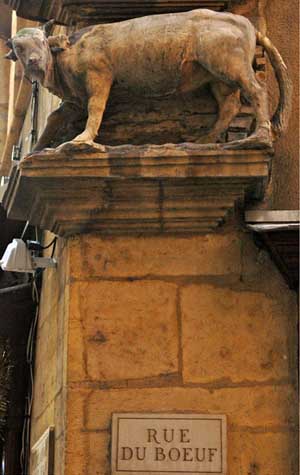
This street in Paris was named "Crossbow Street" because this was once where people practised this skill.
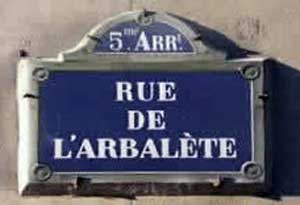
Nobel prize winners, the Curies who discovered X-rays are worthy of their street status!
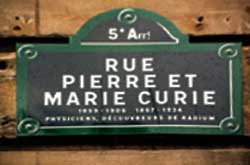
Voltaire was an 18th century writer and philospher celebrated for his cleverness and wit.
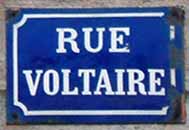
Jean Moulin was a World War II Resistance hero who died in the hands of the Nazis.
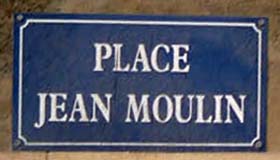
Molière is one of the most famous playwrights of France, who wrote comedies in the 17th century which are still considered amusing today.
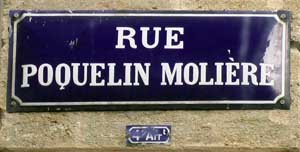
Paul Doumer was President of France in 1931 for just a short time before he was assassinated.
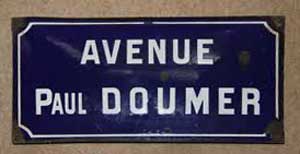
Some street signs seem to be just very unusual. Little Rue Piza (Pisa of leaning tower fame) has been renamed for the composer, Verdi.
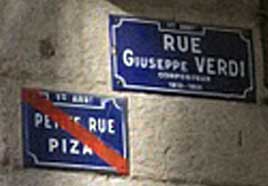
A steep little backstreet in the mountains (note the "grimpon" which suggests a steep climb), is named after a porcupine!
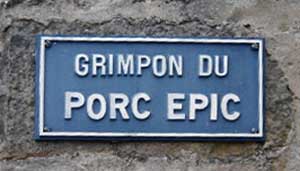
|
The origin of this strange street name (Bad Boys Street) seems to lie in the fact that in the 1500s there were many apprentices who lived and worked here, and many were not too well behaved!
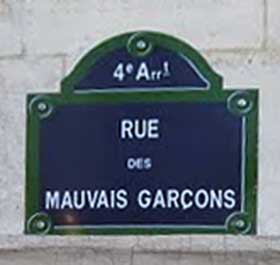
|
|







